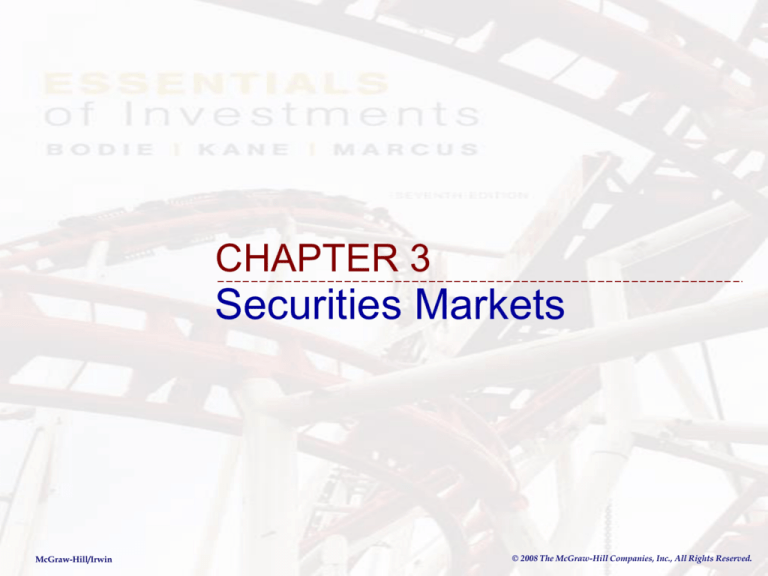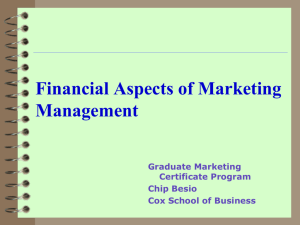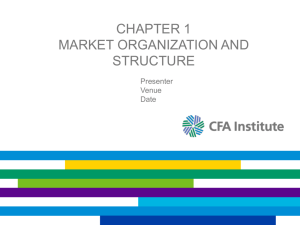
CHAPTER 3
Securities Markets
McGraw-Hill/Irwin
© 2008 The McGraw-Hill Companies, Inc., All Rights Reserved.
3.1 HOW FIRMS ISSUE SECURITIES
3-2
Primary Versus Secondary Markets
PRIMARY MARKET
SECONDARY MARKET
-firstly issued securities
are traded
-existing securites are
traded
- Issuers raise new
capital
- Issuers do not raise
new capital
3-3
IPOs
Initial Public Offerings (IPOs): Selling
stock to the public for the first time. Stocks
are issued by a formerly privately owned
company (Investment Banking)
3-4
IPOs
1. Go to the brokerage firm
2. Investigation
3. Visit the company
4. Prepare proposal and suggest a price
band.
5. Issue prospectus on financial times or
other newspapers.
3-5
How Securities Are Issued
Investment Banking: Public offerings of both
stocks and bonds are marketed by
investment bankers.
Primary market activities can be divided into
two as best effort selling and underwriting
activities.
Best Effort Selling: Investment banking firm
does not buy the entire issue from the issuer
but agrees to use its expertise to sell the
securities.
3-6
IPOs
Underwriting: Underwriters purchase the
securities from the issuer and promises to
sell them at a specified price during the
determined period.
– Stand-by Underwriting
– Firm Commitment (Bought Deal)
Underwriting discount (fee)
Underwriting Syndicate
3-7
Figure 3.1 Relationship Among a Firm
Issuing Securities, the Underwriters
and the Public
3-8
Figure 3.2 A Tombstone Advertisement
3-9
Private Placements
Private placement: Primary offerings in
which shares are sold directly to a small
group of institutional or wealthy investors.
Dominated by institutions
Very active market for debt securities
Not active for stock offerings
3-10
Figure 3.3 Average Initial Returns for
IPOs in Various Countries
3-11
Figure 3.4 Long-term Relative
Performance of Initial Public Offerings
3-12
3.2 HOW SECURITIES ARE TRADED
3-13
Types of Secondary Markets
Direct search: The least orginized market.
Buyers and sellers must seek each other out
directly.
Brokered: In markets where trading in a good is
active, brokers find it profitable to effer search
services to buyers and sellers (real estate
market)
Dealer: Markets in which traders specializing in
particukar assets buy and sell for their own
accounts (Over the Counter-OTC Market).
Auction: Market where all traders meet at one
place to buy and sell an asset (NYSE)
3-14
Types of Orders
Marke orders: buy and sell orders that are to be
executed immediately at current market prices.
– Bid Price
– Ask Price
– Bid-Ask Spread
Price-contingent orders
– Limit buy (sell) order: An order specifiying a price at which they
are willing to buy or sell.
– Stop orders: Trade is not to be executed unless stock hits a price
limit.
– For stop-loss orders, the stock is to be sold if its price falls below
a specified level.
– For stop-buy orders, a stock should be bought when its price
rises above a limit.
3-15
Figure 3.5 Limit Order Book for Intel
on Archipelago
3-16
Figure 3.6 Price-Contingent Orders
3-17
Trading Mechanisms
Dealer markets (OTC market): An informal
network of brokers and dealers who negotiate
sales of scurities.
Electronic communication networks (ECNs):
Computer networks that allow direct trading
without the need for market makers.
Specialists markets: A trader who makes a
market in the shares of one or more firms and
who maintains a fair and orderly market” by
dealing personaly in the market.
3-18
3.3 U.S. SECURITIES MARKETS
3-19
Nasdaq
Nasdaq stock market: The computerlinked priced quotation system for the OTC
market.
3-20
New York Stock Exchange
Stock exchanges: Secondary markets
where already-issued securities are
bought and sold by members.
NYSE:
– Largest exchange in the U.S.
– Automated for small orders
– Floor brokers for large orders
– Specialists
3-21
New York Stock Exchange
Now a publicly held company
Block sales: Large transactions in which at least
10,000 shares of stock are bought and sold.
SuperDot: Electronic ordering system
Bond Trading
– 2006 NYSE obtained approval to expand bond
trading
– However, the vast majority of bond trading occurs in
the OTC market among bond dealers.
3-22
Other Exchanges and Trading Systems
American Stock Exchange (AMEX)
Regionals
Electronic Communication Networks
(ECNs)
National Market System
3-23
3.4 MARKET STRUCTURE IN
OTHER COUNTRIES
3-24
Other Countries
London - predominately electronic trading
Euronext – market formed by combination
of the Paris, Amsterdam and Brussels
exchanges
Tokyo Stock Exchange
3-25
Figure 3.7 Market Capitalization of
Listed Firms, 2005
3-26
3.5 TRADING COSTS
3-27
Trading Costs
Commission: fee paid to broker for
making the transaction
Spread: cost of trading with dealer
– Bid: price dealer will buy from you
– Ask: price dealer will sell to you
– Spread: ask - bid
Combination: on some trades both are
paid
3-28
3.6 BUYING ON MARGIN
3-29
Buying on Margin
is the use of credit to purchase securities
You can borrow up to 50% of the stock value. marginable
securities by using your own assets as collateral. (Initial
Margin)
Benefits;
– Increase the purchaing power of the investors.
Risks associated with margin borrowing;
– The value of the securities you deposited or purchased on
margin may decrease.
– If the equity in your account falls below the min maintenance
level (maintanence margin), a margin call will exist.
– If the margin call occurs, you will be required to increase the
equity up to the min. maintenance levels by immediately
deposited additional funds or marginable securities.
3-30
Margin Trading - Initial Conditions
X Corp
$70
50%
Initial Margin
40%
Maintenance Margin
1000
Shares Purchased
Initial Balance Sheet Position:
Stock $70,000 Borrowed $35,000
Equity
35,000
3-31
Margin Trading - Maintenance Margin
Stock price falls to $60 per share
New Balance Sheet Position:
Stock $60,000 Borrowed $35,000
Equity
25,000
Margin% = $25,000/$60,000 = 41.67%
3-32
Margin Trading - Margin Call
How far can the stock price fall before a
margin call?
Since 1000P - Amt Borrowed = Equity then:
(1000P - $35,000) / 1000P = 40%
P = $58.33
3-33
3.7 SHORT SALES
3-34
Short Sales
Sale of the borrowed securities that are not owned .
It is required from the customers to deposit at least 50%
of the deal for short-selling in cash or in securities.
Purpose: to profit from a decline in the price of a stock
or security
Mechanics
Borrow stock through a dealer
Sell it and deposit proceeds and margin in an account
Closing out the position: buy the stock and return to the
party from which is was borrowed
3-35
Short Sale - Initial Conditions
Z Corp
50%
30%
$100
100 Shares
Initial Margin
Maintenance Margin
Initial Price
Sale Proceeds $10,000
Margin & Equity
5,000
Stock Owed
10,000
3-36
Short Sale - Maintenance Margin
Stock Price Rises to $110
Sale Proceeds
$10,000
Initial Margin
5,000
Stock Owed
11,000
Net Equity
4,000
Margin % (4000/11000)
36%
3-37
Short Sale - Margin Call
How much can the stock price rise before a
margin call?
Since Initial margin plus sale proceeds =
$15,000, then:
($15,000 - 100P) / (100P) = 30%
P = $115.38
3-38
3.8 REGULATION OF
SECURITIES MARKETS
3-39
Self-Regulation
National Association of Securities Dealers
(NASD)
– Oversees participants in the Nasdaq market
NYSE has its own regulatory arm
3-40










